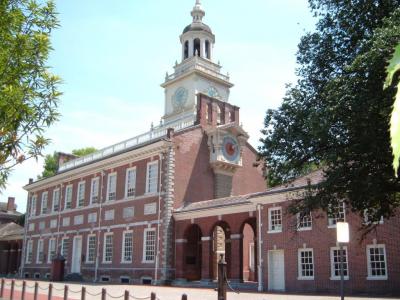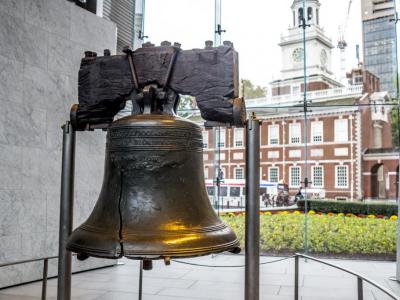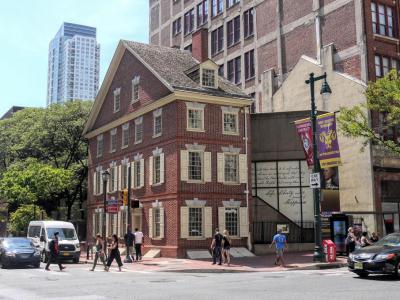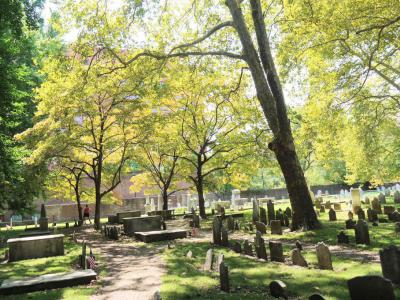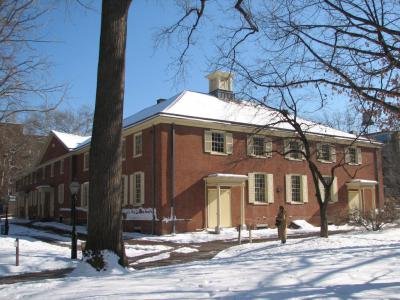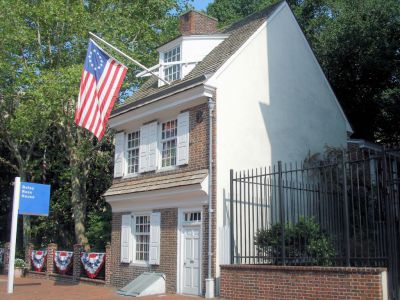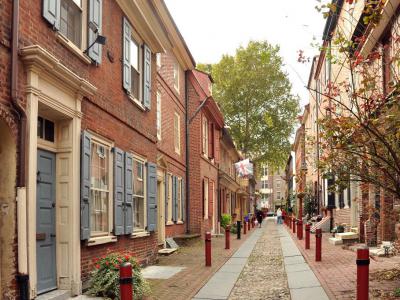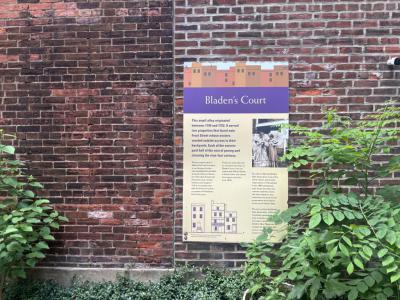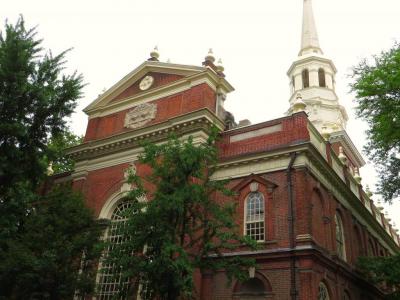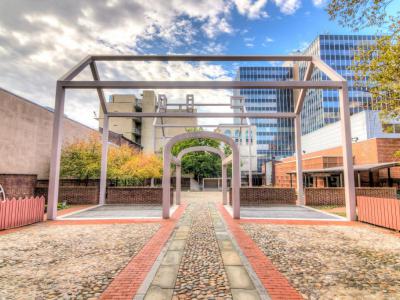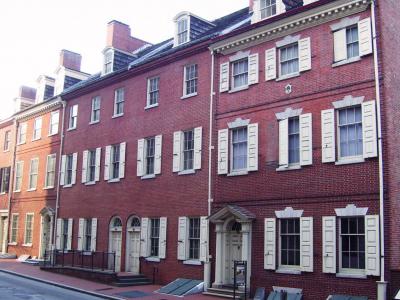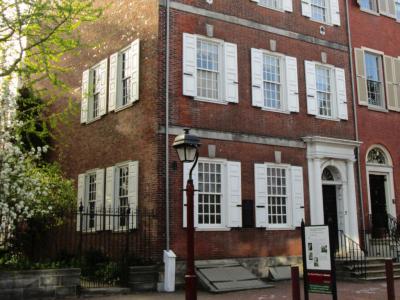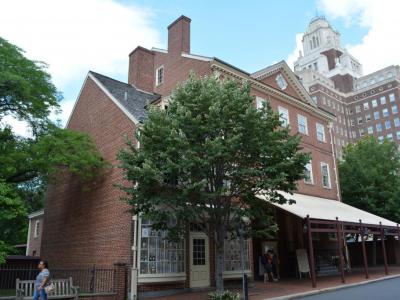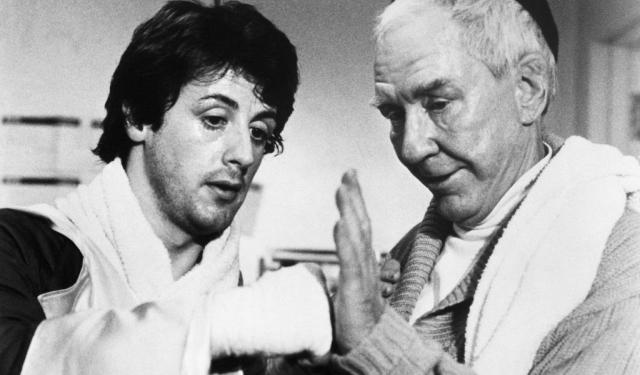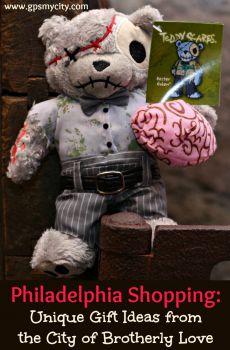Audio Guide: Philadelphia Old City Walking Tour (Self Guided), Philadelphia
King Charles II of England, while seriously indebted to Admiral Sir William Penn, settled his debt in 1681 by granting lands in America to William Penn, the Admiral's Quaker son. A thorn in the King's side, young Penn sailed to America, where he envisioned a utopian society based on tolerance and founded Philadelphia, the "City of Brotherly Love."
The Old City Center, the most historic part of Philadelphia, comprises the streets running east and west between the Delaware and Schuylkill Rivers. Steeped in American history, this area encapsulates the essence of the nation's birth.
At its heart lies Independence Hall, where the Declaration of Independence and the U.S. Constitution were debated and adopted. Nearby stands the Liberty Bell, an enduring symbol of freedom and justice, its cracked visage echoing the struggles and aspirations of the American people. The Declaration House, or Graff House, preserves the modest setting where Thomas Jefferson penned the Declaration of Independence, a pivotal moment in world history.
Adjacent to these landmarks, the Christ Church Burial Ground is the final resting place of Benjamin Franklin, a Founding Father whose intellect and ingenuity shaped early America. The Arch Street Friends Meeting House, a testament to Quaker principles of peace and equality, is a few blocks away, embodying Philadelphia's legacy as a center of religious tolerance.
Further along, the Betsy Ross House honors the woman credited with sewing the first American flag. At the same time, Elfreth's Alley, America's oldest continuously inhabited residential street, offers a glimpse into colonial life. Fireman's Hall Museum celebrate Philadelphia's firefighting heritage, highlighting bravery and community spirit.
Christ Church is where many Founding Fathers worshiped. Not far off, the Benjamin Franklin Museum and Court delivers a detailed overview of Franklin's legacy with interactive elements appealing to visitors of all ages. The Bishop White House and Powel House provide glimpses into the lives of Philadelphia's elite, while City Tavern offers a taste of colonial-era dining and hospitality.
Philadelphia's Old City invites visitors to trace the footsteps of history, where each cobblestone and building resonates with courage and vision. Whether drawn by curiosity or a love of history, a visit here offers a connection to America's founding spirit and enduring values of liberty and justice.
The Old City Center, the most historic part of Philadelphia, comprises the streets running east and west between the Delaware and Schuylkill Rivers. Steeped in American history, this area encapsulates the essence of the nation's birth.
At its heart lies Independence Hall, where the Declaration of Independence and the U.S. Constitution were debated and adopted. Nearby stands the Liberty Bell, an enduring symbol of freedom and justice, its cracked visage echoing the struggles and aspirations of the American people. The Declaration House, or Graff House, preserves the modest setting where Thomas Jefferson penned the Declaration of Independence, a pivotal moment in world history.
Adjacent to these landmarks, the Christ Church Burial Ground is the final resting place of Benjamin Franklin, a Founding Father whose intellect and ingenuity shaped early America. The Arch Street Friends Meeting House, a testament to Quaker principles of peace and equality, is a few blocks away, embodying Philadelphia's legacy as a center of religious tolerance.
Further along, the Betsy Ross House honors the woman credited with sewing the first American flag. At the same time, Elfreth's Alley, America's oldest continuously inhabited residential street, offers a glimpse into colonial life. Fireman's Hall Museum celebrate Philadelphia's firefighting heritage, highlighting bravery and community spirit.
Christ Church is where many Founding Fathers worshiped. Not far off, the Benjamin Franklin Museum and Court delivers a detailed overview of Franklin's legacy with interactive elements appealing to visitors of all ages. The Bishop White House and Powel House provide glimpses into the lives of Philadelphia's elite, while City Tavern offers a taste of colonial-era dining and hospitality.
Philadelphia's Old City invites visitors to trace the footsteps of history, where each cobblestone and building resonates with courage and vision. Whether drawn by curiosity or a love of history, a visit here offers a connection to America's founding spirit and enduring values of liberty and justice.
How it works: Download the app "GPSmyCity: Walks in 1K+ Cities" from Apple App Store or Google Play Store to your mobile phone or tablet. The app turns your mobile device into a personal tour guide and its built-in GPS navigation functions guide you from one tour stop to next. The app works offline, so no data plan is needed when traveling abroad.
Philadelphia Old City Walking Tour Map
Guide Name: Philadelphia Old City Walking Tour
Guide Location: USA » Philadelphia (See other walking tours in Philadelphia)
Guide Type: Self-guided Walking Tour (Sightseeing)
# of Attractions: 14
Tour Duration: 2 Hour(s)
Travel Distance: 3.2 Km or 2 Miles
Author: leticia
Sight(s) Featured in This Guide:
Guide Location: USA » Philadelphia (See other walking tours in Philadelphia)
Guide Type: Self-guided Walking Tour (Sightseeing)
# of Attractions: 14
Tour Duration: 2 Hour(s)
Travel Distance: 3.2 Km or 2 Miles
Author: leticia
Sight(s) Featured in This Guide:
- Independence Hall
- Liberty Bell
- Declaration House (Graff House)
- Christ Church Burial Ground
- Arch Street Friends Meeting House
- Betsy Ross House
- Elfreth's Alley
- Bladen's Court
- Fireman's Hall
- Christ Church
- Benjamin Franklin Museum and Court
- Bishop White House
- Powel House
- City Tavern
1) Independence Hall (must see)
By the late 1720s, Philadelphia was in need of a state house. The ground for its construction – on the south side of Chestnut Street, between Fifth and Sixth Streets, to a design by architect Edmund Woolley – was broken in 1732.
Upon its completion in 1753, the Colonial Government of Pennsylvania took occupancy of the State House immediately. The building served as the Capitol of the Province and Commonwealth of Pennsylvania until 1799.
The former Pennsylvania State House, now known as Independence Hall, is a Georgian-style hall with a red brick facade. There is a central building with a bell tower and steeple. The center is attached by arcaded passageways to wings on either side. The steeple spire is 169 feet high. Old City Hall, Congress Hall, and Independence Hall together with Philosophical Hall, share Independence Square.
The Hall underwent several renovations in the 19th and 20th centuries ultimately restoring its 18th-century appearance. On the ground floor are the Assembly Room and the Supreme Court Room, separated by a vestibule. Behind the entrance is the Tower Stair Hall.
On June 14, 1775, the delegates of the Continental Congress chose George Washington to serve as the commander-in-chief of the Continental Army in the Assembly Room of the Independence Hall. Later, on July 26, the Congress named Benjamin Franklin as the first Postmaster General, a position that eventually evolved into the United States Post Office Department.
From 1775 to 1783, the Independence Hall was the main meeting house of the Second Continental Congress. The Declaration of Independence was approved within its walls on July 4, 1776. The United States Constitution was approved here in 1787.
Ever since then, Independence Hall has often served as a venue for speeches, rallies, and protests. Most events have been held on behalf of democratic and civil rights movements.
Upon its completion in 1753, the Colonial Government of Pennsylvania took occupancy of the State House immediately. The building served as the Capitol of the Province and Commonwealth of Pennsylvania until 1799.
The former Pennsylvania State House, now known as Independence Hall, is a Georgian-style hall with a red brick facade. There is a central building with a bell tower and steeple. The center is attached by arcaded passageways to wings on either side. The steeple spire is 169 feet high. Old City Hall, Congress Hall, and Independence Hall together with Philosophical Hall, share Independence Square.
The Hall underwent several renovations in the 19th and 20th centuries ultimately restoring its 18th-century appearance. On the ground floor are the Assembly Room and the Supreme Court Room, separated by a vestibule. Behind the entrance is the Tower Stair Hall.
On June 14, 1775, the delegates of the Continental Congress chose George Washington to serve as the commander-in-chief of the Continental Army in the Assembly Room of the Independence Hall. Later, on July 26, the Congress named Benjamin Franklin as the first Postmaster General, a position that eventually evolved into the United States Post Office Department.
From 1775 to 1783, the Independence Hall was the main meeting house of the Second Continental Congress. The Declaration of Independence was approved within its walls on July 4, 1776. The United States Constitution was approved here in 1787.
Ever since then, Independence Hall has often served as a venue for speeches, rallies, and protests. Most events have been held on behalf of democratic and civil rights movements.
2) Liberty Bell (must see)
The Liberty Bell, an iconic symbol of American freedom and independence, has a rich and storied history closely tied to Philadelphia, Pennsylvania. Cast in 1752 by the Whitechapel Bell Foundry in London, England, the bell was originally commissioned to mark the 50th anniversary of Pennsylvania's original constitution and to symbolize the ideals of liberty and justice.
Initially hung in the Pennsylvania State House (now known as Independence Hall), the bell gained fame not only for its impressive size and sound but also for its role in important historical events. One popular but apocryphal story links the Liberty Bell to the reading of the Declaration of Independence on July 4, 1776, claiming that it rang out to announce the birth of the new nation. While there is no historical evidence to support this specific event, the bell did gain significance as a symbol of American independence in the ensuing decades.
The bell's inscription, "Proclaim LIBERTY Throughout all the Land unto all the Inhabitants Thereof," from the Bible, became its defining feature and a powerful statement in support of abolitionist movements in the 19th century. Its association with the abolitionist cause led to the bell being dubbed the "Liberty Bell" around the 1830s.
By the mid-19th century, as the bell's structural integrity deteriorated, it was retired from active service. In 1852, it was moved to a pavilion near Independence Hall where it became an object of public veneration. During World War II, the bell's iconic status was further solidified as it was used as a symbol of liberty and freedom, inspiring war bond drives and patriotic sentiment.
Today, the Liberty Bell is housed in the Liberty Bell Center, part of Independence National Historical Park in Philadelphia. It continues to attract millions of visitors each year who come to see and reflect upon its enduring message of liberty, justice, and the ongoing struggle for equality.
Initially hung in the Pennsylvania State House (now known as Independence Hall), the bell gained fame not only for its impressive size and sound but also for its role in important historical events. One popular but apocryphal story links the Liberty Bell to the reading of the Declaration of Independence on July 4, 1776, claiming that it rang out to announce the birth of the new nation. While there is no historical evidence to support this specific event, the bell did gain significance as a symbol of American independence in the ensuing decades.
The bell's inscription, "Proclaim LIBERTY Throughout all the Land unto all the Inhabitants Thereof," from the Bible, became its defining feature and a powerful statement in support of abolitionist movements in the 19th century. Its association with the abolitionist cause led to the bell being dubbed the "Liberty Bell" around the 1830s.
By the mid-19th century, as the bell's structural integrity deteriorated, it was retired from active service. In 1852, it was moved to a pavilion near Independence Hall where it became an object of public veneration. During World War II, the bell's iconic status was further solidified as it was used as a symbol of liberty and freedom, inspiring war bond drives and patriotic sentiment.
Today, the Liberty Bell is housed in the Liberty Bell Center, part of Independence National Historical Park in Philadelphia. It continues to attract millions of visitors each year who come to see and reflect upon its enduring message of liberty, justice, and the ongoing struggle for equality.
3) Declaration House (Graff House)
The Declaration House, also known as the Graff House, stands as a significant historical landmark in Philadelphia. This modest three-story structure was constructed in the 1770s by bricklayer Jacob Graff, who intended the second floor to be rented out for additional income. The house gained historical importance when it became the temporary abode of Thomas Jefferson, a slim, ginger-haired lodger, during a pivotal moment in American history. Jefferson, seeking a tranquil environment away from the bustling city noise, found refuge in this house and accomplished a remarkable feat. It was within these walls, in late spring 1776, that he drafted the Declaration of Independence in just a few weeks.
The house's architecture and design reflect the era of its construction. During its reconstruction 200 years later, many elements typical of the 1770s were meticulously incorporated to preserve its historical authenticity. This includes the Flemish Bond brick checkerboard pattern visible on its walls, windows adorned with paneled shutters, and an array of period-appropriate knickknacks. Unlike the larger, more symmetrical homes in Society Hill, the Graff House is notably small and asymmetrical, with a distinctly off-center front door. Preceding this entrance is a quaint garden, adding to the house's historical charm.
Today, the Declaration House serves not only as a reminder of Jefferson's monumental task but also as an educational site. Visitors are greeted with a short film about Jefferson's life and his drafting of the Declaration of Independence. A replica of his draft of the Declaration is also on display. The house, therefore, stands as a testament to the extraordinary circumstances and humble settings that played a backdrop to one of the most significant documents in the United States' history.
The house's architecture and design reflect the era of its construction. During its reconstruction 200 years later, many elements typical of the 1770s were meticulously incorporated to preserve its historical authenticity. This includes the Flemish Bond brick checkerboard pattern visible on its walls, windows adorned with paneled shutters, and an array of period-appropriate knickknacks. Unlike the larger, more symmetrical homes in Society Hill, the Graff House is notably small and asymmetrical, with a distinctly off-center front door. Preceding this entrance is a quaint garden, adding to the house's historical charm.
Today, the Declaration House serves not only as a reminder of Jefferson's monumental task but also as an educational site. Visitors are greeted with a short film about Jefferson's life and his drafting of the Declaration of Independence. A replica of his draft of the Declaration is also on display. The house, therefore, stands as a testament to the extraordinary circumstances and humble settings that played a backdrop to one of the most significant documents in the United States' history.
4) Christ Church Burial Ground
Christ Church Burial Ground in Philadelphia is an important early-American cemetery, which is still active. Despite the name, it is actually three blocks west of Christ Church. The land was acquired in 1719 when the church's property was full, and the new land was on what was back then considered the outskirts of town.
Christ Church is an Episcopal church founded in 1695, and it was the place of worship for many Revolutionary War participants, including George Washington.
Here is the final resting place of many historic national figures and prominent Philadelphians, including Benjamin Franklin and his wife Deborah, as well as four other signers of the Declaration of Independence: Benjamin Rush, Francis Hopkinson, Joseph Hewes, and George Ross. Two more signers (James Wilson and Robert Morris) are buried at Christ Church itself.
The Burial Ground is open to the public for a small fee. When the Burial Ground is closed, one can still view Benjamin Franklin's gravesite from the sidewalk at the corner of 5th and Arch Streets through a set of iron rails. The rail opening in the brick wall was added for public viewing in 1858 at the request of the Franklin Institute.
It is an old Philadelphia tradition for people to leave pennies at Franklin's resting place.
Further away from Franklin, the visitors can see a small but neatly kept space with lesser-known graves, some of which are also quite interesting.
Christ Church is an Episcopal church founded in 1695, and it was the place of worship for many Revolutionary War participants, including George Washington.
Here is the final resting place of many historic national figures and prominent Philadelphians, including Benjamin Franklin and his wife Deborah, as well as four other signers of the Declaration of Independence: Benjamin Rush, Francis Hopkinson, Joseph Hewes, and George Ross. Two more signers (James Wilson and Robert Morris) are buried at Christ Church itself.
The Burial Ground is open to the public for a small fee. When the Burial Ground is closed, one can still view Benjamin Franklin's gravesite from the sidewalk at the corner of 5th and Arch Streets through a set of iron rails. The rail opening in the brick wall was added for public viewing in 1858 at the request of the Franklin Institute.
It is an old Philadelphia tradition for people to leave pennies at Franklin's resting place.
Further away from Franklin, the visitors can see a small but neatly kept space with lesser-known graves, some of which are also quite interesting.
5) Arch Street Friends Meeting House
Located at the intersection of Arch Street and 4th Street in the historic Old City neighborhood of Philadelphia, the Arch Street Meeting House stands as a significant emblem of the Religious Society of Friends, commonly known as the Quakers. This Meeting House, renowned for its embodiment of the Quaker principles of simplicity and equality, has remained largely unchanged since its inception.
The history of the Meeting House dates back to 1701 when William Penn, the founder of Pennsylvania and a Quaker himself, deeded land specifically for a burial ground to the Society of Friends. The construction of the meetinghouse began in the early 19th century, with its east wing and center being built between 1803 and 1805. This initial construction was the work of Owen Biddle Jr., a Quaker master-builder who is also remembered for his influential builder's handbook, "The Young Carpenter's Assistant," published in 1805.
Today, the Meeting House remains a vibrant center for worship and various activities conducted by the Monthly Meeting of Friends of Philadelphia and the Philadelphia Yearly Meeting. It has been a gathering place for many notable members of the Religious Society of Friends, including the famous abolitionists and women's rights advocates Sarah and Angelina Grimke, as well as Edward Hicks, a renowned painter and cousin of Elias Hicks.
The Arch Street Meeting House was listed on the National Register of Historic Places in 1971 and elevated to the status of a National Historic Landmark in 2011, primarily as the only surviving documented work of Owen Biddle.
The history of the Meeting House dates back to 1701 when William Penn, the founder of Pennsylvania and a Quaker himself, deeded land specifically for a burial ground to the Society of Friends. The construction of the meetinghouse began in the early 19th century, with its east wing and center being built between 1803 and 1805. This initial construction was the work of Owen Biddle Jr., a Quaker master-builder who is also remembered for his influential builder's handbook, "The Young Carpenter's Assistant," published in 1805.
Today, the Meeting House remains a vibrant center for worship and various activities conducted by the Monthly Meeting of Friends of Philadelphia and the Philadelphia Yearly Meeting. It has been a gathering place for many notable members of the Religious Society of Friends, including the famous abolitionists and women's rights advocates Sarah and Angelina Grimke, as well as Edward Hicks, a renowned painter and cousin of Elias Hicks.
The Arch Street Meeting House was listed on the National Register of Historic Places in 1971 and elevated to the status of a National Historic Landmark in 2011, primarily as the only surviving documented work of Owen Biddle.
6) Betsy Ross House (must see)
The story goes that Mrs. Eizabeth Claypoole, also known as Betsy Ross, had a visit from George Washington in 1776. She persuaded him, some say, that a five-pointed star was better than a six-pointed star. Betsy was an upholsterer, and she had been making flags for the Pennsylvania Navy. Flags were her specialty.
True or not, this captivating tale was told by her grandsons, William and George Canby, in the 1870s. People loved it, and it became a popular national legend. Number 239 Arch Street in Philadelphia is where Betsy is said to have lived with her third husband, John Claypoole. The house is a restoration done by architect Richardson Okie in 1940.
The "Betsy Ross" house that stands today may have been the house used by Betsy for her business. The residence of Betsy and her husband was adjacent to the present house. The houses next door were demolished and turned into a courtyard.
Richardson Okie used materials from the demolished houses in his restoration. A brick structure was built behind the house. Windows and a dormer were replaced. The whole property was gifted to the city of Philadelphia in 1941. In 1974 the courtyard was provided with a fountain.
As part of the American Bicentennial of 1976, city authorities moved the remains of Betsy and her husband, John Claypoole. They were reinterred in the courtyard of the Betsy Ross House. Betsy is thought to have resided in the house from 1776 until 1779.
John Ross, Betsy's first husband, a member of the militia, died in a gunpowder explosion. Her second husband, Joseph Ashburn, a mariner captured by the British, died in prison in Plymouth, England. John Claypoole was a fellow prisoner. He knew Ashburn. Betsy married Claypoole in 1783.
The Betsy Ross House is traditionally the site of Philadelphia's celebration of Flag Day. This legendary woman lived and worked here for a few short years when the Great Experiment began. Whatever else she may have done, she made flags.
True or not, this captivating tale was told by her grandsons, William and George Canby, in the 1870s. People loved it, and it became a popular national legend. Number 239 Arch Street in Philadelphia is where Betsy is said to have lived with her third husband, John Claypoole. The house is a restoration done by architect Richardson Okie in 1940.
The "Betsy Ross" house that stands today may have been the house used by Betsy for her business. The residence of Betsy and her husband was adjacent to the present house. The houses next door were demolished and turned into a courtyard.
Richardson Okie used materials from the demolished houses in his restoration. A brick structure was built behind the house. Windows and a dormer were replaced. The whole property was gifted to the city of Philadelphia in 1941. In 1974 the courtyard was provided with a fountain.
As part of the American Bicentennial of 1976, city authorities moved the remains of Betsy and her husband, John Claypoole. They were reinterred in the courtyard of the Betsy Ross House. Betsy is thought to have resided in the house from 1776 until 1779.
John Ross, Betsy's first husband, a member of the militia, died in a gunpowder explosion. Her second husband, Joseph Ashburn, a mariner captured by the British, died in prison in Plymouth, England. John Claypoole was a fellow prisoner. He knew Ashburn. Betsy married Claypoole in 1783.
The Betsy Ross House is traditionally the site of Philadelphia's celebration of Flag Day. This legendary woman lived and worked here for a few short years when the Great Experiment began. Whatever else she may have done, she made flags.
7) Elfreth's Alley (must see)
In the 18th century, Philadelphia became a bustling city, overcrowded with artisans, tradesmen, shipwrights, metalsmiths, glassblowers, and furniture makers. As a result, the landowners Arthur Wells and John Gilbert started a cart path from Front Street to Second Street in 1703. The path became Elfreth's Alley, named after Jeremiah Elfreth, an 18th-century blacksmith and a man of property in young Philadelphia.
By the 1770s Georgian and Federal-style houses lined the cobblestone Alley. Many of the structures were uniquely Philadelphian Trinity houses. These were three-story houses, exceptionally narrow, with one room on each floor. The floors were referred to as "Father, Son, and Holy Ghost." And that is how Trinity houses got their name.
In the 19th and 20th centuries, the industry started to close in on the Alley. A stove factory took its place in a row of residential houses. Immigrants, hoping for jobs, came in waves. In 1934 the Elfreth's Alley Association (EAA) was founded by Alley resident Dolly Ottey. Ottey fought to combat the deterioration of the Alley by encroaching industry in the early 20th century.
Elfreth's Alley Museum is located in houses 124 and 126. The museum preserves the home of 18th-century dressmakers. Tour guides discuss other homes and inhabitants of the Alley. On "Fete Day" in early June, which celebrates Alley's diverse ethnic heritage, the residents open their homes. There are historical reenactments with drum and fife bands. The Alley also host events for the 4th of July, Oktoberfestivities, and Halloween.
By the 1770s Georgian and Federal-style houses lined the cobblestone Alley. Many of the structures were uniquely Philadelphian Trinity houses. These were three-story houses, exceptionally narrow, with one room on each floor. The floors were referred to as "Father, Son, and Holy Ghost." And that is how Trinity houses got their name.
In the 19th and 20th centuries, the industry started to close in on the Alley. A stove factory took its place in a row of residential houses. Immigrants, hoping for jobs, came in waves. In 1934 the Elfreth's Alley Association (EAA) was founded by Alley resident Dolly Ottey. Ottey fought to combat the deterioration of the Alley by encroaching industry in the early 20th century.
Elfreth's Alley Museum is located in houses 124 and 126. The museum preserves the home of 18th-century dressmakers. Tour guides discuss other homes and inhabitants of the Alley. On "Fete Day" in early June, which celebrates Alley's diverse ethnic heritage, the residents open their homes. There are historical reenactments with drum and fife bands. The Alley also host events for the 4th of July, Oktoberfestivities, and Halloween.
8) Bladen's Court
Bladen's Court, a charming side alley inside Elfreth's Alley, originated between 1749 and 1752. This nine-foot cartway was created to serve two properties facing onto Front Street, providing their owners with outside access to their backyards. The alley was a collaborative effort between the two property owners, William Rush and his brother-in-law Abraham Carlisle, who each paid half of the costs for paving and cleaning the narrow passage.
The historical narrative of Bladen's Court is enriched by the contrasting political affiliations of its original owners during the American Revolution. William Rush was a patriot, aligning himself with the revolutionary cause, while Abraham Carlisle chose to collaborate with the British during their occupation of Philadelphia. This divergence in loyalties had dramatic consequences, with Carlisle being hanged in 1778 for his collaboration.
In the early 1800s, the alley became known as Bladen's Court, named after William Bladen, a biscuit maker who owned the property during that period.
The historical narrative of Bladen's Court is enriched by the contrasting political affiliations of its original owners during the American Revolution. William Rush was a patriot, aligning himself with the revolutionary cause, while Abraham Carlisle chose to collaborate with the British during their occupation of Philadelphia. This divergence in loyalties had dramatic consequences, with Carlisle being hanged in 1778 for his collaboration.
In the early 1800s, the alley became known as Bladen's Court, named after William Bladen, a biscuit maker who owned the property during that period.
9) Fireman's Hall
Housed in an old firehouse that was operational between 1902-52, this unique museum was designed for the Bicentennial to showcase Philadelphia's rich firefighting history and the first organized volunteer fire company in Colonial America – the Union Fire Company – established by Benjamin Franklin in 1736. Another reminder that the Founding Father had a hand in everything!
The building still contains the original brass sliding pole used for quick access to fire trucks. Several other pieces of old equipment are on display, including an 1896 hook-and-ladder, a 1903 high-pressure Cannon Wagon, and a 1907 steam-powered pumper. Of special note are two well preserved hand-pumpers – one from 1815, and the other from 1730. Also on display are axes, saws, nozzles, old fire plaques indicating insured buildings, and leather fire hats from the early 19th century. A large stained-glass window memorializes fallen firefighters.
The building still contains the original brass sliding pole used for quick access to fire trucks. Several other pieces of old equipment are on display, including an 1896 hook-and-ladder, a 1903 high-pressure Cannon Wagon, and a 1907 steam-powered pumper. Of special note are two well preserved hand-pumpers – one from 1815, and the other from 1730. Also on display are axes, saws, nozzles, old fire plaques indicating insured buildings, and leather fire hats from the early 19th century. A large stained-glass window memorializes fallen firefighters.
10) Christ Church (must see)
Christ Church in Philadelphia, established in 1695 by the Church of England, quickly became a pivotal religious and historical site. A year later, the congregation erected their first wooden structure, but due to rapid growth, they built a grander temple in the 1720s, the most sumptuous in the Thirteen Colonies.
Christ Church's congregation included 15 signers of the Declaration of Independence, hence it is often called the "Nation's Church". Noteworthy American Revolutionary War leaders like George Washington, Robert Morris, Benjamin Franklin, and Betsy Ross attended this church. Brass plaques mark the pews where they once sat. Washington's pew is #56, Franklin's pew is #70, and Betsy Ross's pew is #12.
Among other things, this church is also celebrated for its stunning Georgian architecture, influenced by Christopher Wren's designs in London. It features a symmetrical facade, arched windows, and a beautifully simple interior characterized by fluted columns and wooden pews. Uniquely, the church has clear windows instead of the traditional stained glass, filling the interior with natural light and views of the surroundings.
Constructed primarily between 1727 and 1744, with its steeple added in 1754, Christ Church stood the tallest building in the future United States for over fifty years. The church underwent significant modifications with a rebuild in 1777 and interior alterations in 1883.
The churchyard is the final resting place of prominent figures such as two signers of the Declaration of Independence, Robert Morris and James Wilson. Christ Church remains a vibrant Episcopal parish and a National Historic Landmark, attracting over 250,000 visitors annually. On-site docents are always there to answer questions, should you have any.
Tip:
Don't miss the collection of historical artifacts, including the 14th-century baptismal font in which William Penn (founder of the Province of Pennsylvania) was baptized, along with a rare book collection and communion elements crafted in the 1790s.
Christ Church's congregation included 15 signers of the Declaration of Independence, hence it is often called the "Nation's Church". Noteworthy American Revolutionary War leaders like George Washington, Robert Morris, Benjamin Franklin, and Betsy Ross attended this church. Brass plaques mark the pews where they once sat. Washington's pew is #56, Franklin's pew is #70, and Betsy Ross's pew is #12.
Among other things, this church is also celebrated for its stunning Georgian architecture, influenced by Christopher Wren's designs in London. It features a symmetrical facade, arched windows, and a beautifully simple interior characterized by fluted columns and wooden pews. Uniquely, the church has clear windows instead of the traditional stained glass, filling the interior with natural light and views of the surroundings.
Constructed primarily between 1727 and 1744, with its steeple added in 1754, Christ Church stood the tallest building in the future United States for over fifty years. The church underwent significant modifications with a rebuild in 1777 and interior alterations in 1883.
The churchyard is the final resting place of prominent figures such as two signers of the Declaration of Independence, Robert Morris and James Wilson. Christ Church remains a vibrant Episcopal parish and a National Historic Landmark, attracting over 250,000 visitors annually. On-site docents are always there to answer questions, should you have any.
Tip:
Don't miss the collection of historical artifacts, including the 14th-century baptismal font in which William Penn (founder of the Province of Pennsylvania) was baptized, along with a rare book collection and communion elements crafted in the 1790s.
11) Benjamin Franklin Museum and Court
The Benjamin Franklin Museum lies in the fully-enclosed courtyard where the Founding Father's house and print shop once stood. Although these were torn down long ago, some archaeological remains were excavated and are visible beneath glass windows in the ground along with explanatory signs.
"Ghost" houses were built in the exact spots where the house and print shop once stood, so one gets a real sense of how the site would have looked when those structures were standing. There is also a working 18th-century print shop adjacent which is a neat experience.
It doesn't cost anything to walk through Franklin Court, view the "ghost" houses, or visit the working print shop. The museum costs a very reasonable fee. While the space is not huge, it provides a very thorough and interesting overview of Franklin's life and contributions to the country. There are lots of interactive objects for kids and fascinating things to see, read, and ponder for adults.
The visitors can get both an overview of Franklin's life, as well as little interesting tidbits of trivia about him. They even have entertaining videos illustrating some humorous (and informative) episodes in his life, which seem to be everyone's favorite part. All in all, there is something for everyone, regardless of age.
"Ghost" houses were built in the exact spots where the house and print shop once stood, so one gets a real sense of how the site would have looked when those structures were standing. There is also a working 18th-century print shop adjacent which is a neat experience.
It doesn't cost anything to walk through Franklin Court, view the "ghost" houses, or visit the working print shop. The museum costs a very reasonable fee. While the space is not huge, it provides a very thorough and interesting overview of Franklin's life and contributions to the country. There are lots of interactive objects for kids and fascinating things to see, read, and ponder for adults.
The visitors can get both an overview of Franklin's life, as well as little interesting tidbits of trivia about him. They even have entertaining videos illustrating some humorous (and informative) episodes in his life, which seem to be everyone's favorite part. All in all, there is something for everyone, regardless of age.
12) Bishop White House
The Bishop White House, an example of Colonial and Federal elegance, stands as a significant historical landmark in Philadelphia. Constructed in 1786, this upper-class residence was the home of the Reverend Dr. William White, the first Episcopal Bishop of Pennsylvania. Dr. White, who was instrumental in founding the Episcopal Church following the break with England, resided in this house from its construction in 1787 until his death in 1836.
Renowned for his role as rector of both Christ Church and Saint Peter's Church, Bishop White also served as the chaplain to the Continental Congress. His home, a center of social and political life, hosted many notable figures of early America, including George Washington and Benjamin Franklin. George Washington notably dined in this house in November of 1798.
Restored to its late 18th-century grandeur, the Bishop White House now forms a part of the Independence National Historical Park. This restoration offers contemporary visitors an authentic glimpse into the life of a prosperous Philadelphian from that era. The house is furnished with period artifacts, many of which are original and were owned by Bishop White himself. This includes around 150 books from his extensive personal library, displayed prominently in the second-floor study, along with his original bed and personal effects.
Renowned for his role as rector of both Christ Church and Saint Peter's Church, Bishop White also served as the chaplain to the Continental Congress. His home, a center of social and political life, hosted many notable figures of early America, including George Washington and Benjamin Franklin. George Washington notably dined in this house in November of 1798.
Restored to its late 18th-century grandeur, the Bishop White House now forms a part of the Independence National Historical Park. This restoration offers contemporary visitors an authentic glimpse into the life of a prosperous Philadelphian from that era. The house is furnished with period artifacts, many of which are original and were owned by Bishop White himself. This includes around 150 books from his extensive personal library, displayed prominently in the second-floor study, along with his original bed and personal effects.
13) Powel House
Built in the 1760s, this elegant Georgian mansion was originally the home of Samuel Powel, a prominent political figure and the last mayor of Philadelphia under British rule. The house is renowned not only for its beautiful red-brick facade and symmetrical design but also for its significant role in American history.
Throughout the late 18th century, Powel House served as a hub for Philadelphia's social and political elite, hosting influential figures such as George Washington and Benjamin Franklin. The interiors, meticulously restored to reflect the grandeur of its era, feature ornate furnishings, exquisite woodwork, and period-specific decor, offering visitors a glimpse into colonial-era opulence and lifestyle.
Visitors can admire its decorative arts collection, which includes portraits of the Powel family. Additionally, the house features a formal, walled garden that is characteristic of the colonial era, offering a glimpse into the horticultural practices of the period.
Throughout the late 18th century, Powel House served as a hub for Philadelphia's social and political elite, hosting influential figures such as George Washington and Benjamin Franklin. The interiors, meticulously restored to reflect the grandeur of its era, feature ornate furnishings, exquisite woodwork, and period-specific decor, offering visitors a glimpse into colonial-era opulence and lifestyle.
Visitors can admire its decorative arts collection, which includes portraits of the Powel family. Additionally, the house features a formal, walled garden that is characteristic of the colonial era, offering a glimpse into the horticultural practices of the period.
14) City Tavern
The City Tavern offers great food, fantastic service in period dress, and an outstanding atmosphere. Though not the original built-in 1773, but a historically accurate replication from 1976, you would be hard-pressed to know.
The original suffered fire damage in 1834 and was razed in 1854. Congress petitioned the Independence National Historical Park to preserve and protect this property, literally one where the Founding Fathers dined, drank ale, and argued political philosophy. Curiously, it was Ben Franklin who introduced tofu to the Americas, and the tofu pasta inspired by his recipe can be enjoyed in his private dining room.
One just needs to see the menu, which includes such delicacies as Thomas Jefferson's favorite sweet potato biscuits, chocolate bread pudding, turkey pot pie based on Martha Washington's recipe, West Indies pepper pot soup, and ales brewed according to Washington's and Jefferson's original recipes.
Guests can stay inside for the colonial ambiance or choose to dine outdoors in the back garden area. The restaurant also features an acclaimed kids' menu, so a visit here with young ones isn't just about the historical and educational experience.
The original suffered fire damage in 1834 and was razed in 1854. Congress petitioned the Independence National Historical Park to preserve and protect this property, literally one where the Founding Fathers dined, drank ale, and argued political philosophy. Curiously, it was Ben Franklin who introduced tofu to the Americas, and the tofu pasta inspired by his recipe can be enjoyed in his private dining room.
One just needs to see the menu, which includes such delicacies as Thomas Jefferson's favorite sweet potato biscuits, chocolate bread pudding, turkey pot pie based on Martha Washington's recipe, West Indies pepper pot soup, and ales brewed according to Washington's and Jefferson's original recipes.
Guests can stay inside for the colonial ambiance or choose to dine outdoors in the back garden area. The restaurant also features an acclaimed kids' menu, so a visit here with young ones isn't just about the historical and educational experience.
Walking Tours in Philadelphia, Pennsylvania
Create Your Own Walk in Philadelphia
Creating your own self-guided walk in Philadelphia is easy and fun. Choose the city attractions that you want to see and a walk route map will be created just for you. You can even set your hotel as the start point of the walk.
Rocky Movie Sites Walking Tour
There's hardly any other character, fictional or real, as iconically Philadelphian as Rocky. Indeed, this American sports drama franchise, centered on the boxing career of Rocky Balboa, released in 1976, has become synonymous with and arguably done more for the city of Philadelphia than anyone else since Ben Franklin.
The cultural phenomenon was created by Sylvester Stallone, who wrote,... view more
Tour Duration: 3 Hour(s)
Travel Distance: 6.3 Km or 3.9 Miles
The cultural phenomenon was created by Sylvester Stallone, who wrote,... view more
Tour Duration: 3 Hour(s)
Travel Distance: 6.3 Km or 3.9 Miles
Benjamin Franklin's Philadelphia
Benjamin Franklin's journey to becoming one of the most influential figures in Revolutionary America began when he, as a teenager, ventured from a Puritan family in Boston to Philadelphia. This city would not only become his home but also a stage for his remarkable life as a writer, printer, philosopher, postmaster, scientist, inventor, statesman, and diplomat. His life epitomizes the... view more
Tour Duration: 2 Hour(s)
Travel Distance: 2.5 Km or 1.6 Miles
Tour Duration: 2 Hour(s)
Travel Distance: 2.5 Km or 1.6 Miles
Fairmount Park Historical Houses Walking Tour
Fairmount Park, Philadelphia's oldest park, established since 1867, is also the city's largest municipal park, sprawling over 2,000 acres adjacent to the banks of the Schuylkill River. The park grew out of the Lemon Hill estate of Henry Pratt, whose land was originally owned by Robert Morris, signer of the Declaration of Independence.
In 1972, the park was placed on the National... view more
Tour Duration: 2 Hour(s)
Travel Distance: 4.7 Km or 2.9 Miles
In 1972, the park was placed on the National... view more
Tour Duration: 2 Hour(s)
Travel Distance: 4.7 Km or 2.9 Miles
Franklin Parkway Walking Tour
Benjamin Franklin Parkway is a scenic boulevard running through the cultural heart of Philadelphia. Named for America's Founding Father, Benjamin Franklin, this mile-long tree-lined parkway is lined with several notable sights and world-class museums.
At its heart lies Logan Circle, a charming green space centered around a picturesque fountain. This spot can provide a refreshing break on... view more
Tour Duration: 2 Hour(s)
Travel Distance: 2.6 Km or 1.6 Miles
At its heart lies Logan Circle, a charming green space centered around a picturesque fountain. This spot can provide a refreshing break on... view more
Tour Duration: 2 Hour(s)
Travel Distance: 2.6 Km or 1.6 Miles
University of Pennsylvania Walking Tour
As America's first university, The University of Pennsylvania (aka Penn or Upenn, for short) has a history stretching back to the mid-18th century, closely bound with the city's colonial past and the birth of the United States. Initially, this Ivy League institution emerged as the College of Philadelphia, one of the nine colonial colleges chartered before the US Declaration of... view more
Tour Duration: 2 Hour(s)
Travel Distance: 2.2 Km or 1.4 Miles
Tour Duration: 2 Hour(s)
Travel Distance: 2.2 Km or 1.4 Miles
Philadelphia Introduction Walking Tour
The sixth largest city in the United States and the largest in the Commonwealth of Pennsylvania, Philadelphia is a dynamic city heaped with old-world charm and contemporary infrastructure. Notable for its rich history, primarily as the birthplace of "life, liberty, and the pursuit of happiness."
Often called Philly, Philadelphia is also known as the City of Brotherly Love – a... view more
Tour Duration: 2 Hour(s)
Travel Distance: 2.3 Km or 1.4 Miles
Often called Philly, Philadelphia is also known as the City of Brotherly Love – a... view more
Tour Duration: 2 Hour(s)
Travel Distance: 2.3 Km or 1.4 Miles
Useful Travel Guides for Planning Your Trip
Philadelphia Souvenirs: 13 Unique Gift Ideas from the City of Brotherly Love
Looking for a great gift while visiting Philadelphia? Famous for its history, arts and culture, championship sports teams, and award-winning food and drink, Philadelphia is a top-rated shopping destination. Here, you'll find an amazing selection of items to choose from - something uniquely...
The Most Popular Cities
/ view all



